Harislau : Utility Poultry & Fancy Pigeons
John S Harrison

The Development of 'Autosexing' Breeds
In 1858 Charles Darwin published 'On the Origins of Species by Means of Natural Selection' sparking off a revolution against the established view on the creation and development of of all living creatures; Gregor Mendel, a Czechoslovakian monk born in 1822, took great interest in the ideas of 'Darwinism' and in 1866 following extensive experiments using peas, published his findings on inheritance, which today we know as "Mendel's Laws of Inheritance".
Mendel's work received very little interest primarily because it was published in a university journal with very limited circulation. Two years later Mendel was made Abbott of the monastery, and his research work was greatly curtailed; when he died in 1884 there was still little recognition of his work and it is reputed that following his death all his papers and the records of his work were burned by the monastery. In the years following Mendel's death details of his work continued to spread, and the importance of his findings finally realised.
In 1900 the British scholar Professor William Bateson of Cambridge University re-presented Mendel's paper to the Royal Horticultural Society in London; Bateson coined the word 'genetics' and was instrumental in bringing Mendel's Laws of Heredity to the attention of English speaking scientists. One of his greatest disciples was Reginald Crundall Punnett who was born in 1875. Punnett was interested in Mendelian experimentation with both plants and animals and between 1904 and 1910 collaborated with Professor Bateson at Cambridge University on hybridization experiments with sweet peas and poultry: their research greatly extended the knowledge and understanding of the importance of Mendelian genetics.
In 1905 Reginald Punnett published a textbook on Mendelism, and introduced the now widely used "Punnett square" a chequer board depicting the number and variety of genetic combinations. In addition to his scientific research Punnett had a great interest in poultry breeding and during World War I advised the Government on all aspect of poultry breeding. In 1910 he became Professor of Biology at Cambridge and in 1912 became Professor of Genetics, the first in Britain. As a consequence of his research with poultry Professor Punnett wrote 'Heredity in Poultry' which was published in 1923 and was the standard work on poultry genetics for many years.
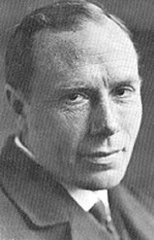 Professor Reginald Punnett
Professor Reginald Punnett
During the late 1920's Professor Reginald C Punnett identified a sex-linkage between gold males and silver females; if, for example, eggs from a Rhode Island Red cock (gold) and Light Sussex hens (silver) are hatched all the pullets will be a darker gold in colour and the cockerels a pale yellow. Punnett subsequently identified a sex-linked barred feather pattern and as a direct result of these two factors instigated a series of breeding programs to investigate the possibilities of utilising this knowledge for practical purposes, the result of which were the Autosexing Breeds.
During the 1920's and 30's Professor Punnett and his team, including Michael Pease, at Cambridge developed several autosexing breeds following the creation of the Cambar in 1929 from the Gold Campine and the Barred Rock; whilst elsewhere in Britain and the rest of the World, other universities and individual breeders took onboard the newly found knowledge and developed more autosexing breeds. In 1943 the Autosexing Breeds Association was formed demonstrating the commercial importance of the new breeds, yet in 1967, less than 25 years after it's formation the ABA was disbanded. Professor Punnett retired in 1940, at the age of 75, though he continued his research into poultry genetics well into the 1950's and died in 1967 at the grand age of 92 years.
Before World War II almost all poultry in Britain, and else where in the World, even on commercial scale, were either pure breeds, or a first cross between two breeds; large scale commercial hybrid strains were unknown, so the research at Cambridge into autosexing had been in line with the idea of farming using pure breeds.The need for the autosexing breeds had run it's course and poultry farming around the world had changed dramatically.
The use of modern commercial hybrids replaced the use of pure breeds as commercial layers and meat birds, and during the late 1930's and early 1940's poultry farming around the word was revolutionised; firstly by the introduction of large scale electric forced-draught incubators, and secondly by the development of day-old chick vent-sexing techniques by Professor Kiyoshi Masui in Japan: the Japanese vent-sexers could achieve almost 100% success. The world of poultry farming had changed, and there seemed little use for the auto-sexing breeds. However even today the developers and producers of some commercial hybrids still utilise autosexing techniques in their breeding programmes.
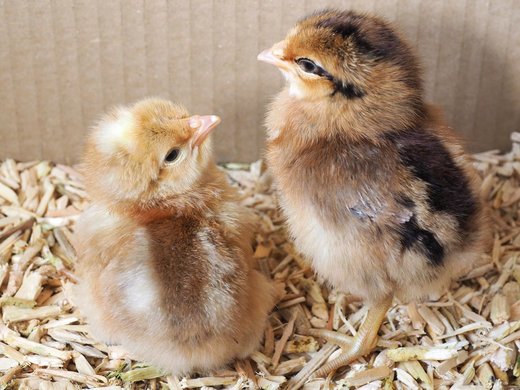
Cockerel Pullet
Day-old Welbar chicks
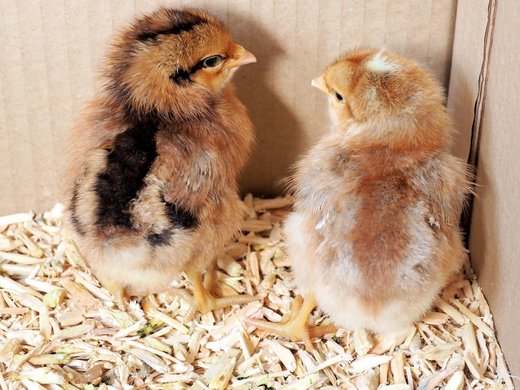 Pullet Cockerel
Pullet Cockerel
Day-old Welbar chicks
Much of Professor Punnett's work in the creation of Autosexing breeds had been based on barred plumage, and numerous crosses were made using the Barred Plymouth Rock, a very popular utility breed of the day, from these crosses Punnett & his team had successfully proved not only the theory but had also created a small group of Autosexing breeds., after the initial Cambar was derived from the Campine.
The 'barring' pattern is sex-linked, the cockerels having two chromosomes and the pullets only one, this results in the chicks of a barred breed have a light coloured patch on the top of the head; in chicks with black down both sexes are very similar and sexing at day old will not be 100% accurate. However, when the barring is combined with brown colouring there is a very clearly defined dark brown stripe down the body. The cockerels on the other-hand have a light patch covering most of the head and there is only a very blurred, indistinct body stripe and overall the down is much paler - the differences between the sexes at day old are very obvious and enable 100% accuracy. Because the ability to sex chicks of the Autosexing Breeds straight from the incubator is such an important factor many of their Breed Standards contain description of the down colouring in addition to the adult plumage.
The Autosexing breeds were given somewhat uninspiring names reflecting their origins, however it must be remembered that they were intended as Utility breeds. The Autosexing Breeds are breeds, they are neither cross-breds nor hybrids, but are genuinely pure-breeding breeds. The Rare Breed Survival Trust defines a breed as:
"A group of animals that has been selected by humans to possess a set of inherited characteristics that distinguishes it from other animals within the same species. In case of poultry, breeds must be recognised by a governing body and accepted as a standardised breed according to British Standards. Colour variants will normally be considered as part of the same interbreeding population unless there is evidence of genetically distinct origins and these variants are not interbred".
The Poultry Club of Great Britain approved individual Breed Standards for them, but they were quickly superceded by commercial hybrids and never 'took off' as exhibition varieties, today they are very much a minority interest and these breeds, created for practical utility purposes, have all but disappeared.
The UK National Database for AnGR (Animal Genetic Resources) in the UK Country Report on Farm Animal Genetic Resources 2002 published by DEFRA provides the following information:
| Breed | Status |
| Brussbar | Critical |
| Legbar | Critical |
| Cream Legbar | Endangered |
| Rhodebar | Critical |
| Welbar | Vulnerable |
| Wybar | Critical |
From where the data was obtained is unclear, but there appears to be some question as to the accuracy of the data for the Cream Legbar is without any doubt the most popular of the autosexing breeds and is certainly far more plentiful than the Welbar. It is possible to identify many breeders with the Cream Legbar, but the Welbar is certainly as scarce as the Rhodebar, and the number of breeders of either of these latter breeds can certainly be counted on the fingers of one hand!
Defra has introduced Legislation in relation to Articles 13.40 of the Avian Influenza Directive 2005/94/EC which allows for instances where Avian Influenza is confirmed on a premises, and any birds on that premises that are listed as a rare breed (by Defra) may potentially benefit from the derogation from culling, providing such derogations do not endanger disease control - the list includes the Welbar, Rhodebar and Legbar.
All the Autosexing breeds with perhaps the exception of the Cream Legbar are now extremely rare and in danger of extinction; of course it would be quite possible to re-create them - assuming that the original component breeds have not been lost as well. It is important that this valuable genetic material is maintained ....... these breeds may still have their uses, and maybe, just maybe, they will be wanted again one day.
Autosexing Breeds around the World
Whilst the Autosexing Breeds started in Great Britain, they are not exclusive to the Britain, and breeds do exist in other countries.
In Canada, the University of British Columbia in Vancouver made the first cross between utility strains of Barred Plymouth Rock and Rhode Island Red and by 1947/8 had established the Rhodebar, but unfortunately 20% of the chicks could not be reliably sexed at day-old. At the same time in Great Britain the Rhodebar was also created.
The Amrock is also a German dual-purpose breed, developed from the old type of Barred Rocks imported into Germany before the breed was perfected as Plymouth Rock. The Amrocks was recognised in 1958. In continental Europe there are a couple of other atosexing breeds, the Norske Jærhøn being the only 'native' Norwegian breed;and from Germany comes the Niederrheiner.
It is interesting to note that as recently as the 1970's Gerd Roth, a breeder in Germany, created the Bielefelder Kennhühn, an autosexing breed very similar in appearance to the Welbar. This breed, officially recognised in 1980, is reputedly a true dual purpose breed which was created from the Cuckoo Maline, Amrock, New Hampshire Red, and the Wyandotte; it has only recently reached the British Isles, and could prove to be a very useful utility breed. The creation of this breed so recently does prove that there is still interest in the autosexing breeds, albeit a minority interest!
The Genetics of Autosexing Breeds
Sex-Linkage and Autosexing are not the same; whereas most sex-linked matings are crosses between two breeds (for example Light Sussex and Rhode Island Red) or colours and the offspring will not breed true; Autosexing breeds however do breed true.
The principle of sex-linkage is based on the fact that male birds have 2 sex chromosomes whereas the hen has only 1; if a gene is located on the sex chromosome it follows therefore that whilst the hen can only have 1 gene at that locus the cock will have 2. The gene for barring (B) as seen in the Barred Plymouth Rock is located on the sex chromosome, and is therefore a sex-linked gene. In cocks showing barring the genotype can be either B/B or B/b+, whereas in the barred hen it can only be B/-, with non-barred birds being b+/b+ and b+/-.
The basis of Autosexing Breeds relies on the interaction of sex-linked barring (B/B and B/-) with ‘wild’ type colouring (e+/e+) as seen in the Brown Leghorn, Brown Sussex and Welsummer. Birds showing barring on wild type colour (e+/e+) are generally referred to as ‘crele’. The fact that cockerels have 2 genes for barring whereas pullets only have 1 gene results in the visual difference in the down of newly hatched chicks and enables the chicks to be sexed as soon as they have dried off, the pullets having a sharply defined dark brown stripe over the head and down the body whilst the cockerels are overall much paler with a light patch covering most of the head and a very blurred, indistinct body stripe.
It was this fact that Prof. Punnett and his team utilised in the creation and development of the first Autosexing breeds in the 1920’s and 1930’s; their work was carried on by other breeders around the world into the 1940’s. All the Autosexing Breeds with ‘bar’ in the name are based on the sex-linked gene for barring, and followed a similar creation process to the Welbar created in the 1940's by Mr Humphrey.
The Welsummer is at base level, ignoring the presence of modifiers, a bird of wild colouring and the addition of the gene for sex-linked barring changes the Welsummer into the Welbar. The sole difference between the Welsummer and the Welbar is the presence or absence of the gene for barring.
The basic genotypes of the Welsummer and Welbar may be identified as:
e+/e+ b+/b+ Welsummer Cock
e+/e+ b+/- Welsummer Hen
e+/e+ B/B Welbar Cock
e+/e+ B/- Welbar Hen
The following chart shows the stages required to produce an Autosexing breed, in this case the Welbar, for other Autosexing the Welsummer could be substituted for the Brown Sussex/Brussbar, Brown Leghorn/Gold Legbar, etc.
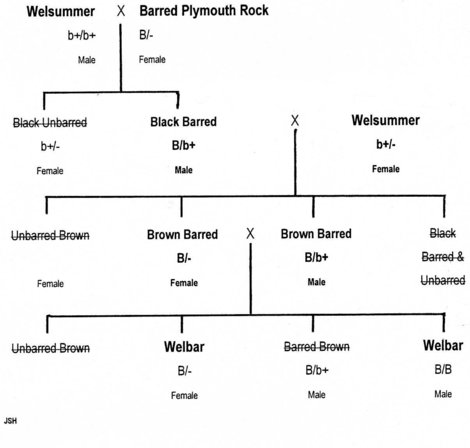
Many people have queried why a Welsummer cock to Barred Plymouth Rock hens is advocated for the initial cross thinking that it would be much faster to mate a Barred Plymouth Rock cock with Welsummer hens.The answer to this question is simply that the aim was to add barring to the Welsummer and produce an autosexing breed and NOT add Welsummer characteristics to the Plymouth Rock!
One of the second generation black barred cockerels mated to Welsummer hens will produce brown barred offspring in both sexes in the third generation. When mated together these brown barred birds will (after rigorous selection) produce Welbars in the fourth generation. Ideally these first Welbars would be bred back to Welsummers for several generations so that the Welbars would have all the characteristics of the Welsummer with the addition of the barred gene.
Following this plan there would only be ONE Barred Plymouth Rock in the breeding program and all the other birds used would be Welsummers whereas if the initial cross was a Barred Plymouth Rock cock over Welsummer hens there would be a far greater Plymouth Rock influence.The aim was simply to add the barred gene to the Welsummer for autosexing purposes and not to produce a new breed with characteristics of both parent breeds - simply put the only characteristic required from the Barred Plymouth Rock was the barred gene and nothing else!
Having produced the Welbar in both sexes the Autosexing Breed has been created and will breed true – however there will be other factors which will have been introduced from the original barred parent which may not be desireble in the Autosexing breed and so whilst early examples of the breed will be autosexing they may not be a uniform breed and therefore selection of breeding stock is very important.
In order to ensure that the Autosexing breed is of the same type and characteristics as the ‘parent’ breed it is essential to keep breeding back to the unbarred 'parent' breed until such time that all other characteristics have been fixed and the only difference between the 2 breeds is the presence or absence of barring. In every sense the Welbar is nothing more than a Welsummer with the addition of the gene for barring – the same should apply to Brussbars, Rhodebars, Wybars etc. and their 'parent' breeds. The importance of regular back crossing cannot be overstated.
The fastest, and easiest way to backcross is to use a 'bar' cock on hens of the parent breed, so for example in the case of the Welbar use a breeding pen consisting of a Welbar cock and Welsummer hens; as shown in the following chart the resulting pullets will all inherit a barred gene from their Welbar father and will by genotype be Welbars :
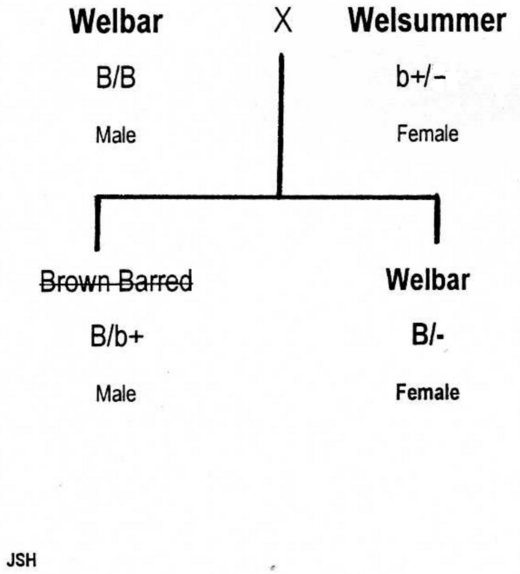
"Willow Shank" Sexing of Chicks
To follow .....
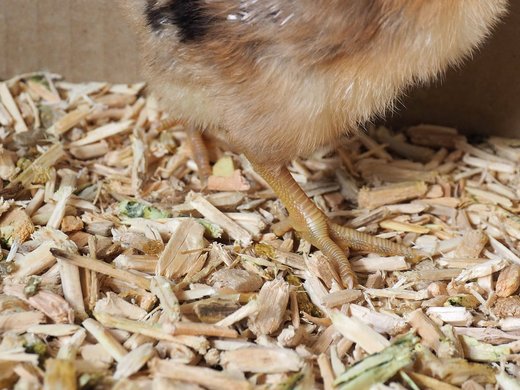
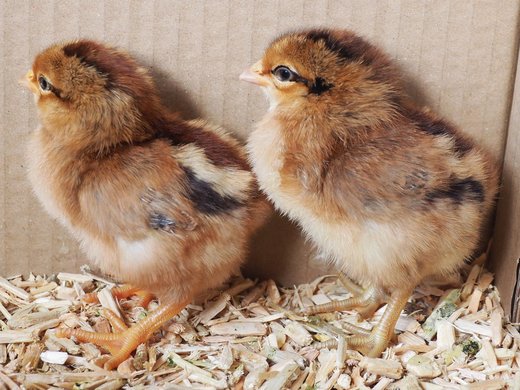
'Orange shank' "Willow shank"
 © John S Harrison
© John S Harrison
Brockbar
Recognised:
United Kingdom
circa 1944 - PCGB
Parentage:
Buff Plymouth Rock (females)
Barred Rock (male)
Classification:
Heavy
Autosexing
Weight:
Cocks - 8 to 9lb
Hens - 7lb
Ring Size:
Cock - 22mm
Hen - 18mm
Egg Colour:
Brown
Buffbar
Recognised:
United Kingdom
1948 - PCGB
Breeder:
Michael Pease, Cambridge
Parentage:
Buff Orpington (hens)
Barred Plymouth Rock (male)
Classification:
Soft Feather Heavy Breed
Autosexing
Average Weight:
Cock 8 to 10lb
Hen 6 to 8lb
Ring Size:
Cock - 24mm
Hen - 22mm
Shell Colour:
Tinted
Brussbar
Recognised:
United Kingdom
Circa 1940 - PCGB
Parentage:
Brown Sussex (females)
Barred Rock (male)
Classification:
Heavy
Autosexing
Colours:
Gold
Silver
Weight:
Cocks - 8 to 9lb
Hens - 7lb
Ring Size:
Cock - 22mm
Hen - 18mm
Egg Colour:
Tinted or light brown
Cambar
Recognised:
United Kingdom
circa 1930 - PCGB
Parentage:
Campine (females)
Barred Plymouth Rock (male)
Classification:
Light
Autosexing
Colours:
Gold
Silver
Weight:
Cocks - 7 to 8lb
Hens - 5 to 5½lb
Ring Size:
Cock - 16mm
Hen - 13mm
Egg Colour:
Tinted
Dorbar
Recognised:
United Kingdom
circa 1944 - PCGB
Parentage:
Dorking (females)
Barred Plymouth Rock (male)
Classification:
Heavy
Autosexing
Meat bird
Colours:
Gold
Silver
Weight:
Cocks - 8 to 9lb
Hens - 7lb
Ring Size:
Cock - 22mm
Hen - 20mm
Egg Colour:
Tinted or white
Legbar
Recognised:
United Kingdom
1933 - PCGB
Breeder:
Professor Reg Punnett, Cambridge University
Parentage:
Brown Leghorn (females)
Barred Plymouth Rock (male)
Birds from Aracauna Indians in Patagonia (females)
Classification:
Soft Feather Light Breed
Autosexing
Layer
Colours:
Gold
Silver
Cream (Crested)
Weight:
Cocks - 7 to 7 ½lb
Hens - 5 to 6lb
Ring Size:
Cock - 18mm
Hen - 16mm
Productivity:
250+
Egg Colour:
White or Cream (Gold & Silver Legbar)
Pastel Blue (Cream Legbar only)
Rhodebar
Recognised:
United Kingdom
1952 - PCGB
Breeder:
Essex & Sussex
Parentage:
Essex
Brussbar male & Rhode Island Red hens
Sussex
Barred Plymouth Rock male & Rhode Island Red hens
Classification:
Soft Feather Heavy Breed
Autosexing
Layer
Average Weight:
Cock 7½lb
Hen 6lb
Ring Size:
Cock - 22mm
Hen - 18mm
Welbar
Recognised:
United Kingdom
1948 - PCGB
Breeder:
Mr H R S Humphrey, Devon UK
Parentage:
Male line - Welsummer (Gold & Silver Duckwing)
Female line - Barred Rock
Classification:
Soft Feather Light Breed
Autosexing
Layer
Colours:
Gold
Silver
Average Weight:
Cock 7½lb
Hen 6lb
Ring Size:
Cock - 20mm (PCGB F20)
Hen - 18mm (PCGB E18)
Productivity:
200 - 220
Shell Colour:
Terracotta to Chocolate
matt preferred
Wybar
Recognised:
United Kingdom
circa 1950 - PCGB
Breeder:
Michael Pease, Cambridge
Parentage:
Gold / Silver Laced Wyandotte (hens)
Barred Plymouth Rock (male)
(Plus Rhode Island Red & Light Sussex for productivity)
Classification:
Soft Feather Heavy Breed
Autosexing
Average Weight:
Cock 8 to 9lb
Hen 7lb
Ring Size:
Cock - 22mm
Hen - 18mm
Shell Colour:
Tinted
European Breeds
Amrock
"American Rock"
(Barred Rock)
Recognised - 1958
Bielefelder Kennhühne
(Cuckoo Maline, Amrock, New Hampshire Red, & Wyandotte)
Recognised - 1980
Norske Jærhøn
Niederrheiner
Other possibilities
The principle aim
of Autosexing breeds was for practical UTILITY purposes.
Other varieties have been created over the years
as 'novelty' or exhibition varieties.
Autosexing breeds
can be created from most (if not all) established breeds,
the following have been created over the years.
Ancobar:
Barred Plymouth Rock x Ancona
Barnebar:
Barred Plymouth Rock x Barnevelder
Cobar:
Barred Plymouth Rock x Cochin
Hambar:
Barred Plymouth Rock x New Hampshire Red
Marbar:
Barred Plymouth Rock x Maran
Miniatures
Miniature or 'Bantam' versions have been created
of various Autosexing Breeds